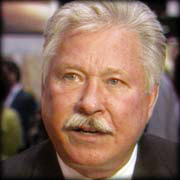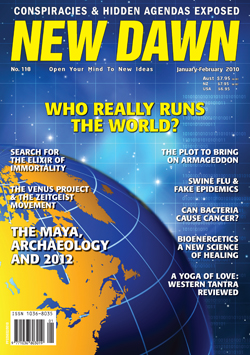From New Dawn 118 (Jan-Feb 2010)
In the “last times,” said the late Rev. Jerry Falwell, “You’ll be riding along in an automobile… When the trumpet sounds, you and other born-again believers in that automobile will be instantly caught away… the car suddenly crashes.… Other cars on the highways driven by believers will suddenly be out of control and stark pandemonium will occur.”1
He was speaking of the Rapture, an integral part of his belief in Armageddon and the return of Christ. He spoke with confidence; did he have any reason to do so?
Around AD 95 a Christian convert called John, exiled by the Roman authorities to the Greek island of Patmos, had a vision of Christ’s return: not the compassionate Christ of the Gospels but a violent one, stained with the blood of his enemies and about to battle against the Antichrist at Armageddon – a site in the Jezreel valley, northern Israel, beneath the brooding ruins of ancient Megiddo.
John wrote a furious and violent text, his Revelation, which after several hundred years was finally included in the New Testament as its final book.
John was certain that the end was coming at any moment. Indeed, he believed that some who had witnessed the crucifixion would still be alive. John was wrong but his apocalyptic prediction of the last days has reverberated through the centuries. Even today there are those who think they will live to witness it.

Fifty-nine percent of all American Christians – according to polls in 2002 – believe that the events described in Revelation will occur in their lifetime; amongst fundamentalist Christians the figure reaches seventy-seven percent. In the last days, they believe, the Messiah – Jesus – will return, win the great battle against Satan (the Antichrist, the Beast) and convert the entire world to Christianity. Thereafter he will rule from Jerusalem.
Beliefs can create events. Ideas are powerful and linger well-entrenched and active in the cultural consciousness. And if those who share these beliefs are serving in an army in the Middle East and think that the ultimate enemy is Satan, what then?
“And the enemy is a guy called Satan”
US Lieutenant General William Boykin, in June 2003, during the Iraq war, laid out such an explanation at a church in Oregon.
“We… are in a spiritual battle, not a physical battle… the battle this nation is in is a spiritual battle, it’s a battle for our soul. And the enemy is a guy called Satan.… Satan wants to destroy this nation.”2
Lieutenant General Boykin has a history: in 1980 he was in the Iranian desert as operations officer for the attempt to free the United States Embassy hostages; in 1989 he was in Panama with the operation to capture President Noriega; in 1993 he was in Colombia with Delta Force, chasing Pablo Escobar, the cocaine baron. That same year Boykin was an adviser on the confrontation with the Branch Davidian sect at Waco, Texas, and by October he was in Somalia, commanding the Delta Force group and was present during the battle of Mogadishu, the subject of Black Hawk Down.
He was appointed head of the Special Operations Division at the Pentagon, moved to the CIA as Deputy Director of Special Activities and then placed in charge of the United States Army Special Forces Command. In 2003–2004 he was involved with the notorious Abu Ghraib prison in Baghdad.
Boykin was not a lone eccentric: when, in 2004, Lieutenant Colonel Gareth Brandl was leading his men in an assault on Falluja, in mid-Iraq, he inspired them by proclaiming, “The enemy has got a face. He’s called Satan. And we’re going to destroy him.”3
Of course, fundamentalist Christians have an escape card that they can play: the Rapture. It is a very simple concept, if you are on the side of Jesus, then you get whisked away by God before the troubles start. If you are somewhere else in the vast realm of religious aspiration then you don’t.
When you get taken there is no warning that allows you to park your car or finish brushing your teeth. God grabs you and you are gone. Implicit in the story is that those left behind actually deserve whatever happens. They are sinners who must be punished. The Rapture does not “do” compassion.
But curiously the Rapture is not mentioned in Revelation. Neither is there any such teaching in Judaism. Islam too is silent on the subject. Nor does Roman Catholic, Orthodox or mainstream Protestant theology contain its story.
In fact, the Rapture is a relatively recent spin on cherry-picked biblical extracts. It has its origins in two sources: the writings of John Nelson Darby (1800–1882), the founder of the Plymouth Brethren and in the commentaries of the Reverend Cyrus Ingerson Scofield (1843–1921) in The Scofield Reference Bible, 1909. The modern picture of the Rapture with its crashing cars and aeroplanes dates from the 1950s and was first launched to a large public audience by fundamentalist preacher Hal Lindsey in 1970 with his book The Late Great Planet Earth.
The Biblical Prophecy Industry
During the morning of 7 June 1967 the future of the Middle East changed dramatically. The Temple Mount was taken by Israeli forces. With the Old City and the Temple Mount in Jewish hands, the Christian fundamentalist prophecy industry went into overdrive. These events, they said, provided direct proof that their understanding of biblical prophecy was correct and that the last days were closing in.
During March and April of 1967 Hal Lindsey was lecturing on college campuses throughout California on the apocalyptic events prophesied in the Bible. His talks centred on the three great events concerning the Jews that would be signs of the return of Jesus and the final defeat of the Antichrist: firstly, the gathering of Jews together to reform their ancient nation; secondly, the possession of Jerusalem and the holy places by Israel; thirdly, the rebuilding of the Temple.4
The first sign was fulfilled on May 14, 1948, with the creation of the modern state of Israel. One can imagine Lindsey’s excitement when Israel took Jerusalem and its holy places, thereby fulfilling the second sign. Would the third event take place? Lindsey had no doubt at all that it would despite his admission that the Dome of the Rock on the Temple Mount was an “obstacle.”
When the Israeli paratroopers took the Temple Mount they assigned one of their young brigade chaplains, Yisrael Ariel, to guard the entrance to the Dome of the Rock. He later recalled thinking that he was simply minding the site until army engineers could come and tear the structure down.5
The expectation of the hard-line fundamentalists was that the Israeli state would take this opportunity to return the Temple Mount to Jewish worship. But the engineers never arrived; the site was maintained as an Islamic place of worship.
Ariel had studied under a messianic teacher, Rabbi Tzvi Yehuda Kook, who saw the influx of Jews into Israel as part of a divine plan and opposed any Arabs holding land that was once Jewish. Kook felt that the time of the Messiah was coming closer; the events in the world about him were a prelude to the last days.
In 1974 a number of Rabbi Kook’s followers organised the West Bank settler movement, the Gush Emunim, whose members flooded into the West Bank and built heavily defended communities. Ariel, by then a rabbi, moved to the hard right of religious Zionism joining the violent and racist Kach political party; in the 1981 elections Ariel was on the Party list. He despised those Jews who did not want to rebuild the Temple and he stated his belief that Christians and Muslims were idol worshippers who, by Jewish law, were forbidden to live in Israel. Then, in 1984, Ariel founded the Temple Institute. Its registration documents state that its long-term aim is to rebuild the Temple.
I first encountered the Temple Institute in January 1992 while on a break from cave-exploration in the high cliffs bordering the Dead Sea. I decided to visit them and hear what they had to say.
There, Rabbi Chaim Richman told a story that left me shaken: members of the Institute wished to remove the Dome of the Rock and the al-AqsaMosque so that the Temple of Solomon could be rebuilt. And to serve the Temple they were training priests in the tradition of blood sacrifice. Richman carefully explained the Institute’s mission:
“The Temple represents harmony; it will bring harmony to the world.”6
He later wrote that Jerusalem would be recognised “as the spiritual centre of all humanity.”7
“Israel,” he added, has the divine mission of being a “kingdom of priests and a holy nation.”8
And this brings us to their interest in the “red heifer.”
A Perfect Red Heifer
Of the many enigmatic stories in the Old Testament, there are few stranger than that related in Numbers 19:1–22 which concerns the sacrifice of, “a red heifer without fault or blemish.” This animal was slaughtered and burned, its ashes gathered and kept in a ritually clean location. These ashes were the most powerful substance known in ancient Judaism to ensure ritual purity.
The orthodox Jews wishing to build the Third Temple today cannot risk entering the Temple Mount in case they inadvertently step upon the site once occupied by the Holy of Holies. Since no one knows exactly where this stood there is only one way of proceeding: to purify the site using the ashes of the red heifer.
As they enter the Temple Mount they will sprinkle sacred water mixed with the ashes of the red heifer to ensure that they do not lose their ritual purity. In this way they can begin the demolition of the Islamic structures.
No such perfect red heifers exist today but Rabbi Richman mentioned a cattle-breeding programme being conducted in the United States with the help of fundamentalist Christian groups that also await the Messiah – for them, Jesus. But Richman was adamant that there was no possibility of Jesus being the Jewish Messiah.
A key figure in this breeding programme was a Christian Pentecostal rancher, the Rev. Clyde Lott of Canton, Mississippi. In 1989 he realised that the Red Angus breed might produce the required animal. Lott and Richman quickly joined forces. During 1991 and 1992 they instituted the breeding program, initially on ranches in the United States but later in Israel. However, producing a perfect heifer proved difficult.
In 1996 a red heifer – named Melody – was finally born on a farm near Haifa though by 1997 she was pronounced unworthy of sacrifice. Since that time a number of others have been born but all have proved less than perfect.
Nevertheless, the Temple Institute presses on. In 2007 they gave an explanation of the importance of the red heifer, commenting that, “A perfect heifer, born and raised under a controlled environment, would be fit to be used for the Temple. And that is precisely what is being done today.”9
I returned to the Temple Institute in 2007, paid my fee and slipped down to join the small group of US Christians. Next to me was Mark from Texas. We were taken to a room containing a large model of the Temple. Our lecturer began explaining the various elements. I noted, leaning against the rear wall of the room, a framed colour photograph of a red heifer. I wondered why it was not hanging on the wall. It seemed oddly disrespectful. And curiously, our lecturer didn’t mention it at all.
As we exited the Temple Institute and were walking up the street, I approached Mark from Texas and asked, “Didn’t Jesus’ death remove the need for animal sacrifices in the Temple?”
“Yes,” replied Mark from Texas with a knowing smile, “He was the sacrificial Lamb of God and stopped animal sacrifice for all time. The Jews don’t recognise that Jesus stopped the animal sacrifices.”
Mark from Texas had touched upon a major difficulty that accompanies Christian support for those Jewish groups wishing to rebuild the Temple. The Christians want the Temple rebuilt because this brings the second coming of Jesus closer. The Jewish groups are happy to accept their patronage since it represents backing for Israel as well as significant financial aid. In addition, of course, both groups are also choosing to ignore that the fundamentalist Christians are intent upon convincing all the Jews that Jesus is the Messiah.
And there is more to worry about: in ancient times there was a Jewish religious authority operating in parallel to the Roman administration, the Sanhedrin, the ultimate authority in matters of the interpretation of Mosaic law and which had the power to impose the death penalty.
After the Temple’s destruction in AD 70, the Sanhedrin moved through a series of sites, the last being Tiberius, around AD 425. And so it was in Tiberius, in 2004, that the new Sanhedrin was convened.
One of the Sanhedrin’s aims is to influence the political direction of Israel, seeking power to veto any laws that it deems incompatible with biblical Jewish law. A leadership council of seven prominent members was formed; this included Rabbi Yisrael Ariel, the founder of the Temple Institute along with his colleague Rabbi Chaim Richman.10 It is no surprise to find that “the Sanhedrin is researching ways to renew the deepest roots of our faith – to renew Temple service.”11
The Mahdi and Jesus Return for the Last Days
The relevance of events of June 1967 was not missed by the Muslims. Their traditional enemies were now in possession of the third most sacred site in Islam. The defeat of the Arab armies ushered in radical Islam which believes the only solution is a world united in a great Islamic state under a Caliph based in Jerusalem ruling by sharia law.
For most Muslims who await the caliphate its appearance would be the sign of the last days when the Messiah – the Mahdi – will appear. And at his side, they believe, will stand Jesus.
But before the Day of Judgment can begin, according to one widely accepted hadith dating from the ninth century AD, all Jews must be slaughtered. This has become an integral part of Middle Eastern politics: the 1988 foundation charter of Hamasstates explicitly that the organisation seeks “to implement Allah’s promise” that the Day of Judgment will not come until the Muslims have killed all the Jews.12
The aim is to ensure that not a single member of the Jewish race survives, then to seize Jerusalem which will become the messianic capital of Islam; to take over all the technology developed by the West and put it in the hands of the true believers and finally, to convert the whole world to Islam, placing Allah’s people into their rightful position – in charge. That, in essence, is the Islamic apocalyptic vision of the last days.
But the Mahdi and his armies are not just fighting a coalition of disparate races; there is a single directing force acting behind them – the Antichrist, the Dajjal.
Modern Islamic writers have gone far beyond traditional texts in the search for material to justify their last days prophecies and the Christian book of Revelation has proved a rich mine to plunder. Material has also been drawn from many other sources, ranging from early Gnostic texts through the prophecies of Nostradamus to modern Western UFO literature.
Best-selling Egyptian author Muhammad Isa Da’ud would have us believe in the existence of, “the Antichrist army of Jinn [spirits] and demons, which kidnap unfortunates who wander into the area of the Bermuda Triangle. Those who are kidnapped are taken down into his fortress castle far beneath the waters.”13
In 1997 Muhammad Izzat Arif, who considered rather more plausibly that this Bermuda Triangle base was above water, explained that, “The truth is that the Antichrist is a power chained on a remote island, sending his orders through demons subordinated to him, and working before him as servants,”14 adding that, “They inspire Jews, and their slaves the Masons.”
These demons under the control of the Antichrist have another specific role: they pilot the UFOs the Antichrist uses. In 1996 writer Hisham Kamal ‘Abd al-Hamidexplained that the flying saucers were not from extraterrestrial sources but rather from the earth, which he reminds us is inhabited by both humans and jinns. He concludes, as we noted earlier, that the “people of flying saucers are demons in human form.”15
Perversely, as noted, much of the material comes from Christian sources, which seem well known to the Islamic writers. Jerry Falwell’s writings are frequently referred to by Muslim apocalyptic writers and he is considered an authority on the end of the world.
Others who receive a mention in the Islamic sources are Caspar Weinberger, Jimmy Swaggart, Jim Bakker, Pat Robertson, Oral Roberts, Kenneth Copeland, Richard De Haan, Billy Graham, and, surprisingly, the Scofield Bible.16
These radical Muslims assume that the world will convert to Islam; the extremist Christians assume the world will convert to Christianity; the Jewish fundamentalists care only that Jews serve on the Temple Mount, they don’t seem to be concerned how the rest of the world shakes out. But all three religions claim Jerusalem as the centre for their Messiah’s rule.
It appears that these apocalyptic writers from the three Abrahamic religions have more in common with each other than with the moderate majority within their own traditions, a majority who generally have no great arguments with each other.
The certainty, self-confidence, and aggressiveness of the fundamentalists is shifting their faith’s centre of gravity toward the rigid and intolerant edges. The hardliners are deliberately encouraging a focus upon differences instead of seeking points of similarity, accord, and mutual understanding. A separation is being created, which, in time, may become too wide to bridge.
Fundamentalist Arrogance and Ignorance
What worries me about all this is the breathtaking arrogance and willful ignorance of spirituality by the fundamentalists of the three faiths. There is no room for any other spiritual systems, no room for Buddhism, Hinduism, Taoism, or the many other perfectly valid paths by which spiritually minded people journey toward knowledge of matters divine.
Fundamentalist Christian authors Tim LaHaye and Jerry Jenkins are blunt, “The idea that all religions point to the same god is blasphemy. So is the idea that there are many ways to God. Buddha, Mary, Gaia, Muhammad, and Christ are not in the same category.… Just one was God’s ‘only begotten Son’, and only He gives us access to God through prayer.”17
The concept of a divine Jesus is a problem for Judaism and Islam. For Muslims, the failure of the other two religions to recognise Mohammed as the last prophet represents an additional conflict point. For the Jews, the failure to recognise the importance of the Temple and its priesthood as a conduit between God and earth is a crucial difficulty. The three positions seem irreconcilable.
Can we continue to live with this or should we reconsider our position towards the anthropomorphic god of the Abrahamic religions? Should we really accept all authority deriving from a vengeful and jealous god who claims to be unique? Should we just sit back and watch as the fundamentalist religious teachings leak inexorably and dangerously into our politics?
We have found ourselves across the Rubicon, by default rather than design. The question is: what are we going to do about it?
Footnotes
1. Ronnie Dugger, “Reagan’s Apocalypse Now,” Guardian (reprinted from Washington Post), April 21, 1984, 19.
2. Esther Kaplan, With God on Their Side, New Press, New York, 2005, 21.
3. Paul Wood, “Hunting ‘Satan’ in Falluja Hell,” BBC News, November 23, 2004, quoted in John Gray, Black Mass: Apocalyptic Religion and the Death of Utopia, Penguin, London, 2007, 28.
4. Hal Lindsey, The Late Great Planet Earth, Zondervan, Grand Rapids, 1970, 50–51.
5. Gershom Gorenberg, The End of Days, Free Press, New York, 2000, 100.
6. Richman, personal communication, January, 1992.
7. Chaim Richman, A House of Prayer for all Nations: The Holy Temple of Jerusalem, Temple Institute, Jerusalem, 1997, 7.
8. Chaim Richman, “Rosh HaShana Blessings from the Temple Institute”, September 21, 2006, www.templeinstitute.org/news.htm.
9. The Temple Institute, “The Red Heifer: The Original Ashes”, www.templeinstitute.org/red_heifer/original_ashes.htm.
10. “Current members of the Sanhedrin”, www.thesanhedrin.org/en/main/officers.html.
11. “Reestablished Sanhedrin Convenes to Discuss Temple”, Arutz-7 IsraelNationalNews.com, February 9, 2005, www.israelnationalnews.com/News/News.aspx/76624.
12. Noted in a submission by the World Union for Progressive Judaism to the fifty-ninth session of the United Nations Commission on Human Rights, February 18, 2003, 5. File No. E/CN.4/2003/NGO/226.
13. David Cook, Contemporary Muslim Apocalyptic Literature, Syracuse University Press, Syracuse, 2005, 78.
14. Ibid, 188.
15. Ibid, 81.
16. Ibid, 92nn9,10, 11.
17. Tim LaHaye and Jerry B. Jenkins, Are We Living in the End Times?, Tyndale, Wheaton, 1999,176.
© New Dawn Magazine and the respective author.
For our reproduction notice, click here.






